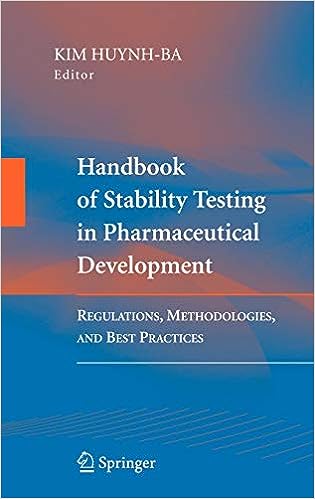Understanding ICH Q7A Guidelines and Their Influence on Stability Testing
Introduction
The International Council for Harmonisation (ICH) Q7A guidelines, focusing on Good Manufacturing Practices (GMP) for Active Pharmaceutical Ingredients (APIs), play a significant role in shaping stability testing programs. By ensuring that APIs meet rigorous quality standards throughout their lifecycle, these guidelines emphasize the integration of GMP principles into stability testing. This article explores the key aspects of ICH Q7A, its impact on stability testing programs, and best practices for compliance.
Overview of ICH Q7A Guidelines
ICH Q7A outlines GMP requirements for APIs, covering all stages of their production, including:
- Manufacturing: Ensuring consistency and quality in API production.
- Storage: Specifying conditions to prevent degradation and contamination.
- Stability Testing: Providing a framework for evaluating the API’s quality over time.
The guidelines aim to harmonize global standards, reducing variability and ensuring compliance across regions.
Key Elements of ICH Q7A in Stability Testing
1. Establishing Stability Testing Programs
ICH Q7A requires manufacturers to design stability testing programs that evaluate the API’s quality under specified storage conditions. Key aspects include:
- Long-Term Testing: Conducted under recommended storage conditions to determine the API’s shelf life.
- Accelerated Testing: Simulating extreme conditions to identify potential degradation pathways.
- Stress Testing: Evaluating API behavior under conditions such as heat, light, and humidity.
Tip: Base stability programs on ICH Q1A(R2) to align with global regulatory expectations.
2. Storage Conditions and Stability Studies
The guidelines emphasize testing APIs under realistic storage conditions relevant to their intended markets. Typical conditions include:
- Long-Term: 25°C ± 2°C / 60% RH ± 5% RH.
- Accelerated: 40°C ± 2°C / 75% RH ± 5% RH.
For APIs intended for hot and humid climates, additional testing under Zone IVb conditions (30°C ± 2°C / 75% RH ± 5% RH) is recommended.
Tip: Customize testing protocols for multi-regional submissions to address varying climatic requirements.
3. Stability-Indicating Methods
ICH Q7A emphasizes the use of validated, stability-indicating analytical methods to monitor API quality. Critical parameters include:
- Assay: Evaluating API potency and active content.
- Impurities: Monitoring the formation of degradation products.
- Physical Properties: Assessing changes in appearance, solubility, and moisture content.
Tip: Develop robust analytical methods capable of detecting minor changes in API quality.
4. Documentation and Record Keeping
Comprehensive documentation is a cornerstone of ICH Q7A compliance. Stability testing records must include:
- Testing Protocols: Detailed descriptions of study design and parameters.
- Raw Data: Complete datasets from all stability studies.
- Summary Reports: Clear interpretations of data, highlighting any significant findings.
Tip: Use electronic systems to streamline data management and ensure traceability.
Impact of ICH Q7A on Stability Testing Programs
1. Enhancing Product Quality
By integrating GMP principles, ICH Q7A ensures that stability testing programs contribute to consistent API quality. Key benefits include:
- Reliability: Robust testing protocols provide reliable data for shelf-life determination.
- Regulatory Confidence: Compliance with GMP standards enhances regulatory acceptance.
2. Streamlining Global Submissions
Harmonized guidelines simplify stability testing requirements for APIs intended for multiple markets. Key advantages include:
- Reduced Redundancy: Unified protocols minimize the need for additional studies.
- Faster Approvals: Consistent documentation supports smoother regulatory reviews.
3. Promoting Risk Management
ICH Q7A incorporates risk-based approaches to stability testing, focusing on critical quality attributes and potential degradation risks. This ensures:
- Targeted Testing: Prioritizing studies that address high-risk degradation pathways.
- Cost Efficiency: Optimized resource allocation for critical testing areas.
Challenges in Implementing ICH Q7A Stability Testing
Compliance with ICH Q7A presents several challenges:
- Analytical Complexity: Developing and validating stability-indicating methods for diverse APIs.
- Data Management: Handling large volumes of stability data across multiple studies.
- Regulatory Variability: Addressing additional regional requirements beyond ICH standards.
Solution: Invest in advanced technologies and engage with regulatory experts to streamline implementation.
Best Practices for Compliance
To align stability testing programs with ICH Q7A guidelines, manufacturers should adopt these best practices:
- Plan Early: Incorporate stability testing into the initial stages of API development.
- Validate Methods: Use validated analytical techniques to ensure reliable results.
- Engage Regulators: Collaborate with regulatory authorities to clarify expectations and address concerns.
- Leverage Technology: Use automated systems for data collection, analysis, and reporting.
- Monitor Post-Approval Stability: Implement ongoing studies to ensure API quality after market entry.
Future Trends in Stability Testing Under ICH Q7A
Advancements in technology and regulatory science are shaping the future of stability testing. Key trends include:
- AI and Predictive Modeling: Leveraging artificial intelligence to forecast API stability trends.
- Sustainability: Adoption of energy-efficient stability chambers and eco-friendly practices.
- Global Harmonization: Continued efforts to align ICH Q7A with regional guidelines for streamlined compliance.
Conclusion
ICH Q7A guidelines significantly influence stability testing programs by integrating GMP principles and harmonizing global standards. By adhering to these guidelines, manufacturers can ensure consistent API quality, achieve regulatory compliance, and streamline global submissions. As advancements in technology and regulatory practices evolve, stability testing programs will continue to play a vital role in delivering safe and effective pharmaceutical products worldwide.
